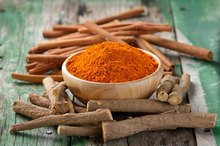Nutrition for Shin Splints
Shin splints is the term used to describe pain that manifests in the front of your lower legs or shins. MedlinePlus states that if you have shin splints, your pain is concentrated along the inside edge of your tibi — the bigger of the two bones in your lower leg. Nutritional remedies have long been used in treating shin splints, although it is always wise to first review the risks of this natural treatment method with your doctor.
Shin Splint Info
The leading cause of shin splints, states the Sports Injury Clinic website, is inflammation of your tibial periosteum — the membrane that lines the outer surface of your bones. Muscle-induced traction forces on your periosteum cause shin splint pain and inflammation. One of the most common symptoms associated with this condition is pain over the inside aspect your shin. Also common symptoms are pain that is worse when you begin exercising, the morning following exercise and pain in the affected region when you point your toes downward.
- The leading cause of shin splints, states the Sports Injury Clinic website, is inflammation of your tibial periosteum — the membrane that lines the outer surface of your bones.
- Also common symptoms are pain that is worse when you begin exercising, the morning following exercise and pain in the affected region when you point your toes downward.
Appropriate Nutritional Supplements
Nutritional Therapy for Temporal Arteritis
Learn More
Nutritional therapies, especially nutritional supplements, may be helpful in treating your shin splints. However, more scientific evidence about these nutritional supplements -- their efficacy, safety and mechanisms of action -- may be required. Nutritional supplements that help reduce inflammation and repair tissue may be most appropriate for this condition. Examples of these nutritional supplements include omega-3 fatty acids, vitamin B complex, vitamin C, essential fatty acids, grape seed extract, proteolytic enzymes, garlic, boswellia and cat's claw, states certified nutritional consultant Phyllis A. Balch, author of "Prescription for Nutritional Healing."
- Nutritional therapies, especially nutritional supplements, may be helpful in treating your shin splints.
- Nutritional supplements that help reduce inflammation and repair tissue may be most appropriate for this condition.
A Helpful Nutritional Supplement
Boswellia produces a gum used in nutritional supplements that are commonly used in Ayurvedic medicine to treat a variety of ailments, notes Balch. Boswellia is well known for its ability to treat inflammation throughout your body, according to the Memorial Sloan-Kettering Cancer Center. It acts as an anti-inflammatory and anti-arthritic agent, and healthcare practitioners such as naturopathic physicians, herbalists and Ayurvedic practitioners have historically used it to treat muscle pain, fibromyalgia, arthritis, gout and lower back pain. It is, therefore, useful for shin splints.
- Boswellia produces a gum used in nutritional supplements that are commonly used in Ayurvedic medicine to treat a variety of ailments, notes Balch.
Additional Information
Pain in My Right Big Toe
Learn More
Shin splints are not a life-threatening health problem, although this musculoskeletal problem can impair your ability to perform your usual work or recreational activities and can significantly reduce your quality of life. Nutritional support in the treatment of shin splints is a natural and often effective approach, but you should always follow your doctor's advice. Avoid self-treating your shin splints with nutritional supplements until you have reviewed the benefits and drawbacks of this natural health approach.
Related Articles
References
- Sports Injury Clinic: Shin Splints (Periostitis)
- "Prescription for Nutritional Healing"; Phyllis A. Balch, CNC; 2010
- Memorial Sloan-Kettering Cancer Center: Boswellia
- Winkelmann ZK, Anderson D, Games KE, Eberman LE. Risk factors for medial tibial stress syndrome in active individuals: An evidence-based review. J Athl Train. 2016;51(12):1049-1052. doi:10.4085/1062-6050-51.12.13
- Pietrzak M. Diagnosis and management of acute medial tibial stress syndrome in a 15 year old female surf life-saving competitor. Int J Sports Phys Ther. 2014;9(4):525–539.
- Galbraith RM, Lavallee ME. Medial tibial stress syndrome: Conservative treatment options. Curr Rev Musculoskelet Med. 2009;2(3):127-133. doi:10.1007/s12178-009-9055-6
- Reinking MF. Exercise related leg pain (ERLP): A review of the literature. N Am J Sports Phys Ther. 2007;2(3):170-180.
- Nielsen RO, Buist I, Sørensen H, Lind M, Rasmussen S. Training errors and running related injuries: A systematic review. Int J Sports Phys Ther. 2012;7(1):58–75.
- Alaia MJ, Fischer SJ. Shin Splints. OrthoInfo. American Academy of Orthopaedic Surgeons. Reviewed August 2019.
- Ma CB, Zieve D, Conaway B. Shin Splints - Self Care. MedlinePlus NIH. Reviewed November 5, 2018.
- Moen MH, Tol JL, Weir A, Steunebrink M, De Winter TC. Medial tibial stress syndrome: A critical review. Sports Med. 2009;39(7):523-46. doi:10.2165/00007256-200939070-00002
- Reshef N, Guelich DR. Medial tibial stress syndrome. Clin Sports Med. 2012;31(2):273-90. doi:10.1016/j.csm.2011.09.008
Writer Bio
Martin Hughes is a chiropractic physician, health writer and the co-owner of a website devoted to natural footgear. He writes about health, fitness, diet and lifestyle. Hughes earned his Bachelor of Science in kinesiology at the University of Waterloo and his doctoral degree from Western States Chiropractic College in Portland, Ore.









